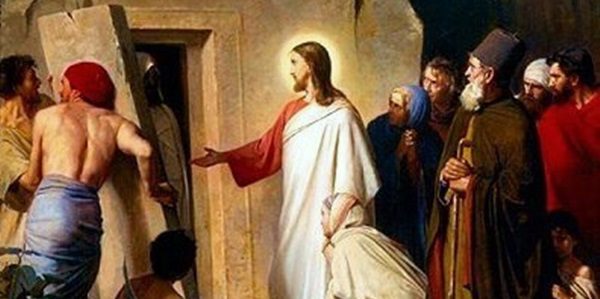 Pastors have a frequent question when they begin to discover mimetic theory. “That’s great. But how does it preach?”
Pastors have a frequent question when they begin to discover mimetic theory. “That’s great. But how does it preach?”
Reverend Tom Truby shows that mimetic theory is a powerful tool that enables pastors to preach the Gospel in a way that is meaningful and refreshing to the modern world. Each Wednesday, Teaching Nonviolent Atonement will highlight his sermons as an example of preaching the Gospel through mimetic theory.
In this sermon, Tom explores Jesus raising Lazarus from death to life. Jesus knows that this act is a challenge to cultural ways of death, and that it will lead to his own death. Tom writes, “Humans attempt to manage divisions through the mechanism of blame, rejection, and exclusion. Jesus has to allow himself to get caught in this cruel machinery if he is to reveal it so we can see it too.” That revelation leads us to hope for a better world.
Year-A Fifth – Sunday in Lent
April 2, 2017
John 11:1-45
“Lazarus, Come Out!”
A man is ill. He lives in a village two miles from Jerusalem, the capital city. His name is Lazarus and his two sisters are Mary and Martha. They are followers of Jesus and they are all close friend. But now Lazarus is seriously ill. The sisters send an urgent message to Jesus who is some distance away. The message reads, “Lord, the one whom you love is ill.” Jesus, come quickly with your healing touch, before it is too late!
Instead of coming immediately Jesus lingers saying, “This illness isn’t fatal. It’s for the glory of God so that God’s Son can be glorified through it.”
It is two days later now and Jesus announces his intention to go to Judea. The disciples try to talk Jesus out of going. “Rabbi, the Jewish opposition wants to stone you, but you want to go back.” Why would you go there; they want to kill you?
Jesus responds, “Aren’t there twelve hours in the day? Whoever walks in the day doesn’t stumble because they see the light of the world. But whoever walks in the night does stumble because the light isn’t in them.”
The disciples are tempting Jesus to deviate from the path God has set before him. The light is God’s Spirit guiding him. To live in it, Jesus must do what God sent him to do when God sends him to do it. Now is the time. The cosmos is set.
What Jesus tells them seems strange: “Our friend Lazarus has fallen asleep, but I am going there to awaken him.” He doesn’t want them to worry about Lazarus! The disciples persist in their attempt to dissuade Jesus. “Lord, if he has fallen asleep, he will be all right.” Why are we going to Judea, that death trap, to wake somebody who has overslept?
Jesus now discloses that Lazarus is dead and they are going to Judea so that the disciples may believe. He is absolutely firm in his resolve. Thomas, that “somber realist,” said to the other disciples, “Let us go too so we may die with him.” I detect a note of sarcasm in his voice. But Laura, my wife, thinks he wants to be strong.
The entourage arrives in Bethany. Lazarus has been in the tomb four days! That means he was already dead when Jesus got the message. Martha comes to meet Jesus and wonders why he didn’t come sooner. They have a conversation about resurrection but Martha doesn’t get it. She leaves Jesus standing there and “goes back and calls her sister Mary, and tells her privately, ‘The Teacher is here and is calling for you.’” Jesus hadn’t actually called for Mary. Maybe she was angry with Jesus and didn’t want to talk to him.
Mary says the same thing Martha said but she says it while kneeling at his feet. “Lord, if you had been here, my brother would not have died.” I get a different feel from Mary. She asks the same question but without pointing the finger of blame. She, too, wants to know why, but the question comes from a place of trust. Their relationship is still intact even though she is as sad as Martha about her brother’s death.
Mary and the people who had followed her out to meet Jesus begin to cry. At this point Jesus becomes deeply disturbed. Why? Was it because he knew what he had to do to bring us to an awareness of God’s resurrection power – and what it would cost him?
Jesus has to work his grief and decide he will do what needs to be done. John doesn’t have a temptation story like the Synoptic Gospels but this is John’s temptation story. Jesus knew if he brought Lazarus to life, it would lead to his own death. In John’s gospel the two are linked.
Jesus resolves to do it and says, “Where have you laid him?” Those around him say, “Lord, come and see.” Aren’t those the same words Jesus used when he called his first disciples? Now God is calling Jesus to come and see where faithfulness will take him. Jesus weeps! Is this the Fourth Gospel’s form of the tears shed in the Garden of Gethsemane?
The religious leaders misinterpret his tears. They can’t see that his tears look forward to what he must soon suffer. Jesus is feeling the weight of all the violence, injustice, innocent suffering and false accusations the world has generated through history. The religious leaders think his tears grow out of his sympathy for his friend or his regret for not arriving sooner. We know they are far more than that; they are tears for the whole world.
Even in their description of Jesus’ behavior, the divisions and the tensions between the leaders appear. “‘The Jews said, ‘See how much he loved him!’” But some of them said, ‘He healed the eyes of the man born blind. Couldn’t he have kept Lazarus from dying?’” I wonder if they mirror the attitude of the two sisters. These are the tensions that make Jesus’ journey to the cross necessary. Humans attempt to manage divisions through the mechanism of blame, rejection and exclusion. Jesus has to allow himself to get caught in this cruel machinery if he is to reveal it so we can see it too.
Waves of awareness seem to be washing over Jesus. Again greatly disturbed he comes to the tomb and says, “Lazarus, come out.” In bringing Lazarus to life, Jesus knows he is condemning himself to death. Hadn’t Jesus said that he would raise Lazarus so that the Son of God may be glorified through it? In John’s Gospel, the glorification of Jesus is the crucifixion and resurrection together. That’s where the Son of Humanity is lifted up.
Jesus, the Word of God made flesh, said to the power of the grave, “Unbind him and let him go.” Bruce Prewer, an Australian pastor and writer, wrote a poem entitled “Lazarus, Come Out!” It captures how Jesus calls us all out of our death entanglements.
Lazarus, come out!
Come out from the career crypt
where frenetic ambition
leaves you no time
for family, prayer or contrition.
Lazarus, come out!
Walk from the burial chamber
that is your mega dollar home
with its security system
and prison-like grills in chrome.
Lazarus, come out!
Escape from the tomb
of academic games you’ve won,
where you dissect many creeds
but trust and follow none.
Lazarus, come out!
Rush from the crematorium
of contemporary lust
that burns you up
and turns your life to dust.
Lazarus, come out!
Break from the pretty tomb
of fashion, where you rob
your own true self
to blend with the shallow mob.
Lazarus, come out!
Forsake the religious coffin
where the pious pray
for a better world
yet don’t live it day by day.
Lazarus, come out!
Come out of the white-washed grave
of voluble churchly word
and pious self-serving.
Follow again the living Lord. Amen.
Image: Carl Heinrich Bloch [Public domain], via Wikimedia Commons.
Stay in the loop! Like Teaching Nonviolent Atonement on Facebook!











